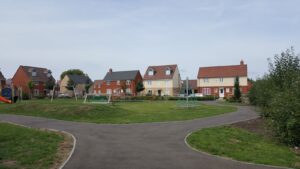Staccato spaces
Nitshill. Glasgow. Matter of fact. Spoken staccato like. This is not a tourist destination. Outside the mostly empty shopping centre is a children’s climbing frame. Blackened. Fenced off. Very little destination in this destination, for anyone. Ironically, the road into this place is sometimes called an ‘Opportunity corridor’.
This is an urban Scotland. In the 1970’s, Ian Adams chronicled the story of the making of urban Scotland. His primary observation is that cities matter: the ordinary condition of the city is of extraordinary significance to the lives of people there. Too often, for too many people, there is no there there. Only blackened monuments.
In 2005, Tessa Jowell wrote an essay published through Demos. It was entitled ‘Tackling the ‘poverty of aspiration through rebuilding the public realm’. It is a good read. In parts. Jowell rightly sees the public realm as the entirety of the realm of public resources, services and spaces. For these, there is collective responsibility and a clear public institutional role. A healthy, open, and socially responsible society she argues, values its public realm.
Recently, there was a consultation about the future of Nitshill. It was located in one of the empty shop units in the mostly empty shopping centre. It was excellent: inclusive, creative, well attended, and interactive. One day, a passer by enquired why he hadn’t been invited. He was from the new private housing on the hill. Not a regular patron of the scant services, limited shopping, and community centre behind the housing block. He didn’t see the posters about what was going on. His public realm is more distributed. Needs are met elsewhere.
Within the mass of ideas, comments, fears and ambitions on the wall of the shop in the consultation, there is a fairly clear headline. People are mostly saying that the key issue they have is with people saying they are going to do something who don’t . Specifically, they are referring to the institutions of the place. Without some lead in the public realm, the condition often becomes the opposite of ‘I will if you will’.
The Public Realm Information Network [PRIAN] observe that any intervention in the streetscape element of public realm involves at least five different agencies. Whereas the planning system is, for some, overburdened with consultation and bureaucracy, action in the public realm kind of happens or never happens. Holes are dug, pipes poked, blacktop put back. However, few are engaged in what is happening, why, and for how long. Often, there is little co-ordination of action.
Regularly, the physicality of public realm is a patchwork of different pavings, bollards, random bins, different lights, an estate of stuff that very few people are able to describe. It is, therefore, hard to say how much it costs to maintain this kind of public space in its present mediocre state. It is hard to say who maintains it, when and how, to what quality. Often, it may be a case that we should be spending the same money in a different way to achieve a much better outcome: potholes filled, bins emptied, useable climbing frames. Ordinary things. These come up in every single consultation in every single urban place. Rarely do they get fixed as easily as they are identified as problems.
Both England and Scotland are looking at cities. Ministers are being identified with responsibility for cities. There will be reviews, analysis, ranking of settlement scales and function, discussion of economic trajectories and positioning: cities as the engine of growth. But how to make it all tangible, to make it all work? If cities matter, they matter because people are there. If people are there, they are on the streets. If we started thinking about the city from the perspective of people who lived and worked at the basic scale of the street, the public realm, and worked outwards from this, how different would the way we make and manage cities look?















